Video of the Week:
Hydrangea: Macrophylla
Fruit:
Peaches and Apricots
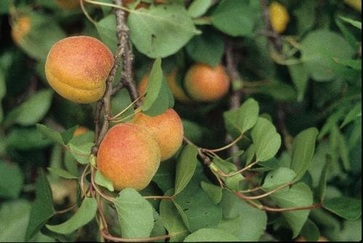
Control insects and diseases: Though it is too late to control peach leaf curl (see http://www.hfrr.ksu.edu/doc3168.ashx), it is possible to control scab and brown rot. Insects of concern are plum curculio, oriental fruit moth, plant bugs, and stink bugs. Use Captan or Immunox to control the diseases, and malathion to control the insects. Spray every 10 to 14 days. Pay attention to the waiting period between the last spray and harvest. See the publication, “Fruit Pest Control for Home Gardens” at http://www.ksre.ksu.edu/bookstore/pubs/c592.pdf for details including organic controls.
Thin peaches: Thin peaches to 1 every 6 to 8 inches to maximize fruit size and to decrease the load on the branches. As a general rule, we need about 40 leaves per peach for maximum quality. Peaches are borne in clusters, so calculate how many a branch can support by dividing the length of the branch in inches by 7. As long as there is an average of 7 inches of branch length per peach, it doesn’t matter whether the peaches are in clusters or not.
Water Trees as Needed: The most critical time for adequate water is during the pit hardening stage which usually lasts between 2 to 4 weeks. Cut open a few peaches to determine when the pit starts to harden or become woody. Irregular watering during this period can lead to split peaches.
Prop up branches if needed: Prop up branches if the fruit load is so heavy the tree may break apart. Use boards with a “V” cut in one end to support the branch. Prune the branch back to a smaller side branch next spring (March). (Ward Upham)
Fruit Sprays and Spray Water pH
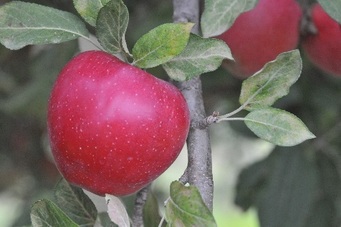
pesticides will break down when mixed with high pH water. So let’s say you mix up your spray mixture by adding malathion and captan to 5 gallons of water. If that water has a pH of 7, the captan will break down so that
only half of it will still be present in 8 hours. However, if the water you use has a pH of 10, half the captan will break down in 2 minutes. Malathion isn’t nearly as sensitive but still will break down under high pH conditions
though it is stable at a pH between 5 and 7. Note that alkaline hydrolysis does not affect all pesticides. Captan is the exception, not the rule. For a listing of common pesticides and their susceptibility to alkaline hydrolysis, see
http://ecommons.library.cornell.edu/bitstream/1813/5149/1/FLS-118.pdf
So how do you bring down the pH of your spray water if it is high? Commercial people use buffering agents but that may be difficult for homeowners to find. Food grade citric acid can help. If you have a pH of 8.0, add 2 ounces of this citric acid per 100 gallons of water (1 and 1/4 teaspoons per 10 gallons) to bring the pH down to about 5.5. (Ward Upham)
Vegetables:
Protecting New Vegetable Transplants from the Wind

far enough so it won’t blow away. In windy conditions, it may need to be stabilized with a wooden dowel or metal rod. (Ward Upham)
Rabbits in the Garden

Often fencing is not an acceptable choice because it affects the attractiveness of the garden. Other ways to control rabbits including repellents, trapping and shooting. Repellents are often suggested for control but often do not last long and require frequent reapplication. Also, many are poisonous and cannot be used on plants or plant parts destined for human consumption. Live traps can be used to collect and move the rabbits to a rural area several miles from where they were trapped. A number of baits can be used to entice the rabbit to enter the trap including a
tightly rolled cabbage leaf held together with a toothpick. However, rabbits often avoid baits if other attractive food is available.
Another possibility is to use a motion-activated sprinkler. These are attached to a garden hose and release a short burst of water when motion is detected. Contech, Orbit and Havahart are suppliers and each is advertised as protecting up to at least 1,000 square feet. Shooting is another possibility when it is safe and legal to do so. (Ward Upham)
Family Heritage Gardening
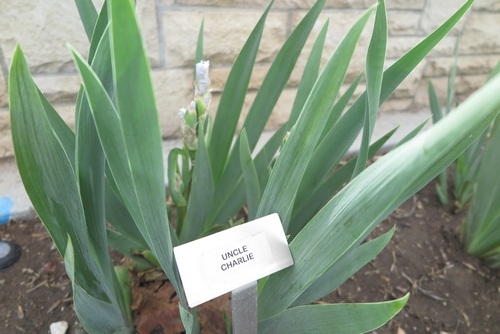
sides of our family as well as a nod to the passion I share with you monthly. Would you like to hear about our amble down the garden path of naming our child?
Everyone, by all accounts, loved my husband’s grandmother. He has fond memories of spending time with her as a young child before she lost her battle with lung cancer in 1990. She had a passion for gardening, which she loved to share with her family. In particular, she had an expansive iris collection, one that her children continue in her honor at their own homes. They made sure to collect rhizomes from her favorite varieties before the homestead was sold many years ago. She was also known for planting a tree for each of her grandchildren so that as they grew, their tree grew as well. My husband says that she and I would have gotten along famously and that if he ever had a little girl, she would share his grandmother’s name: Lola.
Our baby’s middle name is in honor of my grandfather. Yes, I said grandfather. It’s a good story, too. The 7th of 9 children, Grandpa was born on a cold February day in 1927 near Minco, Oklahoma. This was the eve of the Great Depression, a time when funds were often few and far between for many Americans. It was no different for the Kuhlman family, so when the time came for grandpa to be born, a midwife came to assist. My grandfather’s parents, humble German immigrants, couldn’t afford to pay this wonderful woman. A family friend and neighbor, the midwife was full of grace and kindness. Her response to their inability to pay her $3 delivery fee was “That’s okay. Just name the baby after me.” They promised to do so and when the baby came out a boy, they honored their commitment. His name is John Rose Kuhlman.
All three of these people have left legacies worthy of honor. Lola was a caretaker and an all around loving person. John is a man of strong faith whose calling card is a nod to his horticultural moniker. And Rose’s generosity is the stuff, well, legends are made of. I guarantee there were a lot of babies born near Minco with her name—we didn’t think her story should go quietly into the night. We chose to honor their lives and memories in the naming of our daughter.
Meet Lola Rose Boyer. She has quite the heritage surrounding her name. I plan to share my passion for gardening with her and hope that she finds as much delight in it as I do and her namesakes before me.
Have you gardened in honor of a family member? If, like Lola, you would like to have a collection of plants from the same genus who share cultivar names with your loved ones, consider iris, daylily, rose, daffodil, hibiscus, or mum. In fact, a search at http://allthingsplants.com for “Lola” revealed Iris ‘Lola’s Delight’ and Echeveria ‘Lola’ (a succulent sedum variety). A search for my own name revealed several cultivars of iris, daylily, mum and dahlia. If I remember correctly, the mums I bought two years ago were ‘Spicy Cheryl’. Heh heh. Food for thought anyway. I think it will be fun to hunt for cultivars containing “Lola” (and other family member names) as I shop for plants in the coming years.
How have you celebrated a loved one with gardening? Have you planted their favorite plants? Regularly chosen their favorite color? Looked for plants that share their name in the cultivar? Planted a tree for them? Whichever way you choose to honor your loved ones, do it with joy and please, share their legacy with others. (Cheryl Boyer)
Pests:
Sawfly Larvae on Ash
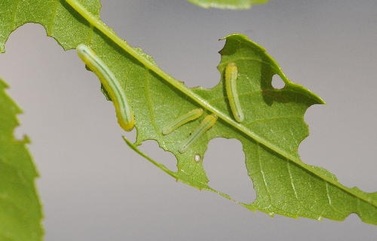
In the middle of the whitish stripe there appears to be a darker green stripe that is actually the digestive tract of the insect. Though sawfly larvae resemble caterpillars, they have at least six pairs of "stublike" prolegs behind the three pairs of true legs on their abdomen. (Caterpillars never have more than five pairs of prolegs.)
There are usually no detrimental effects to the health of the tree if nature is allowed to run its course. Even if all the leaves are eaten, it is early enough in the growing season for trees to put out a complete new set of leaves and still has enough time to make all the food reserves needed to survive the coming winter. However, if control is desired, a number of insecticides can be used for control including cyfluthrin (Bayer Lawn and Garden Multi-Insect Killer), malathion, esfenvalerate (Monterey Bug Buster II) and Sevin. An effective organic product is spinosad (Captain Jack’s Deadbug Brew; Fertilome Borer, Bagworm, Leafminer and Tent Caterpillar Spray). Horticultural oils and insecticidal soaps are also effective because of the soft skin of sawfly larvae. (Ward Upham)
Elm Pocket Gall
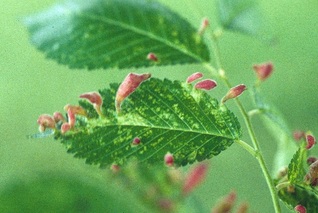
Mites overwinter in bark crevices of the host as fertilized females. In the spring, females stimulate gall growth by injecting saliva into new elm leaves and mites move into galls through open pores on the underside of the leaf. Several generations are completed during the summer. The last generation of the year is produced when the leaf tissue hardens in the fall. Galls cause little damage to the host plant so control is rarely warranted. (Ward Upham)
Aphids
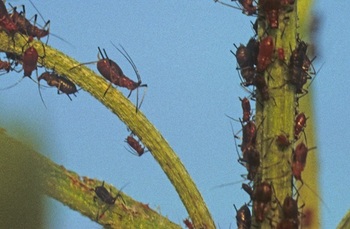
two small “pipes” known as cornicles that project from the rear of their bodies. This ejected, sticky material is called honeydew. This honeydew often becomes black with sooty mold fungus. Automobiles parked under trees with large aphid populations will often be spotted with honeydew. Though the finish will not be harmed by the honeydew, it is a hassle to clean off.
Aphids usually are controlled effectively by nature. Adverse weather conditions such as beating rains and low temperatures, as well as fungus diseases, insect predators and parasites, keep the aphids in check. Aphid enemies include lady beetles, syrphid fly larvae, aphis lions and small wasp parasites known as braconids.
Most insecticide applications destroy beneficial insects as well as pests and leave trees or shrubs unprotected if pest resurgence occurs. Because beneficial insects play an important role in natural aphid control, try washing aphids away with a forceful stream of water (if practical) before using insecticide sprays.
If control measures are warranted, use insecticidal soaps, horticultural oils, malathion, cyfluthrin or permethrin. Reapplication may be needed. Imidacloprid (Annual Tree and Shrub Insect Control, 12 Month Tree & Shrub Insect Control, Max Tree and Shrub Insect Control, Bonide Systemic Granules IC, Bayer Tree and Shrub Insect Control) is a systemic insecticide that can be used to prevent aphid populations from building but must by applied early to allow time for the pesticide to move to the new growth. This time period may vary from one week to three months
depending on the size of the plant with very large trees taking the most time. (Ward Upham)
Ornamentals:
Blackspot of Roses
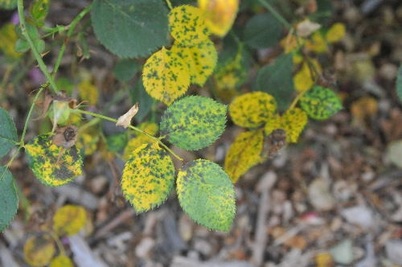
The infection usually starts on the lower leaves and works its way up the plant. Blackspot is most severe under conditions of high relative humidity (>85%), warm temperatures (75 to 85 degrees F) and six or more hours of leaf wetness. Newly expanding leaves are most vulnerable to infection. The fungus can survive on fallen leaves or canes and is disseminated primarily by splashing water.
Cultural practices are the first line of defense.
1. Don't plant susceptible roses unless you are willing to use fungicide sprays. For a list of blackspot resistant varieties, go to: http://www.ppdl.purdue.edu/ppdl/weeklypics/3-22-04.html
2. Keep irrigation water off the foliage. Drip irrigation works well with roses.
3. Plant roses in sun in areas with good air movement to limit the amount of time the foliage is wet.
4. Remove diseased leaves that have fallen and prune out infected rose canes to minimize inoculum.
If needed, protect foliage with a regular spray program (10- to 14-day schedule) ) of effective fungicides. Recommended fungicides include tebuconazole (Bayer Disease Control for Roses, Flowers and Shrubs), myclobutanil (Immunox, Immunox Plus), triticonazole (Ortho Rose & Flower Disease Control) and chlorothalonil (Broad Spectrum Fungicide, Garden Disease Control, others). (Ward Upham)
Contributors: Cheryl Boyer, Nursery Specialist; Ward Upham, Extension Associate
 RSS Feed
RSS Feed
